Traditionally, architectural design has been a labor-intensive process, heavily reliant on the skill and vision of architects. Sketches on paper, physical models, and CAD (Computer-Aided Design) software have been the mainstays of the profession for decades. While these methods have produced iconic buildings and remarkable feats of engineering, they also come with limitations in terms of time, resource management, and adaptability.
With the advent of AI, we are witnessing an unprecedented evolution in architectural practices. AI-driven tools and algorithms now offer the ability to process massive amounts of data, generate design variations, and optimize construction processes, all in a fraction of the time it would take using traditional methods. These advancements are not just incremental improvements; they represent a paradigm shift that is transforming every facet of architecture.
Design Innovation
In the realm of design, AI has introduced capabilities that were once the domain of science fiction. Generative design algorithms can automatically produce a multitude of design options based on specific input parameters like spatial constraints, aesthetic requirements, and environmental considerations. This empowers architects to explore a broader range of possibilities quickly and efficiently, leading to more innovative and optimized designs.
Furthermore, AI can simulate how a building will perform under various conditions long before construction begins. This predictive power allows architects to fine-tune their designs for energy efficiency, structural integrity, and user comfort, reducing the need for costly revisions and ensuring that the final product aligns closely with the original vision.
Planning and Construction Efficiency
AI’s impact extends beyond design into planning and construction, where it brings significant improvements in efficiency and precision. In project planning, AI tools can analyze historical data to forecast timelines, budget requirements, and potential risks. This predictive capability enables more accurate project management, reducing delays and cost overruns that have plagued the construction industry for years.
On the construction site, AI-driven robots and drones are beginning to take on tasks that were previously manual, from bricklaying to quality inspections. These technologies not only accelerate the building process but also enhance safety by taking on hazardous tasks. Additionally, AI can optimize the logistics of materials and resources, ensuring that everything is in the right place at the right time, and minimizing waste.
Sustainability and Smart Buildings
One of the most exciting prospects of AI in architecture is its potential to create more sustainable and intelligent buildings. AI algorithms can optimize energy usage, water consumption, and waste management, leading to buildings that are not only more environmentally friendly but also more cost-effective to operate.
Moreover, AI enables the integration of smart building technologies that adapt to the needs of the occupants, enhancing comfort and productivity. From automated lighting and climate control to advanced security systems, AI is helping to create buildings that are not only sustainable but also intuitive and responsive to human needs.
Midjourney V6: A New Era in Architectural Design
In the ever-evolving landscape of architectural design, Midjourney V6 stands as a pivotal advancement, redefining the boundaries of creativity and efficiency through the power of AI. This latest iteration is not merely an upgrade; it’s a revolutionary toolset specifically tailored to address the complexities and demands of modern architecture.
Unparalleled Precision and Creativity
Midjourney V6 introduces a new level of precision in design elements, ensuring that every detail is meticulously crafted to meet the exact specifications of the project. The AI-driven algorithms are capable of interpreting complex architectural plans and translating them into detailed, visually stunning 3D models. This level of accuracy minimizes errors and significantly reduces the time from conception to completion.
Seamless Integration and User-Friendly Interface
One of the standout features of Midjourney V6 is its seamless integration with other popular design software. Whether you are using AutoCAD, Revit, or SketchUp, the transition to Midjourney V6 is smooth and intuitive. The user-friendly interface is designed to help architects quickly adapt to the new functionalities without a steep learning curve. The ease of use ensures that architects can focus more on innovation and less on navigation and technicalities.
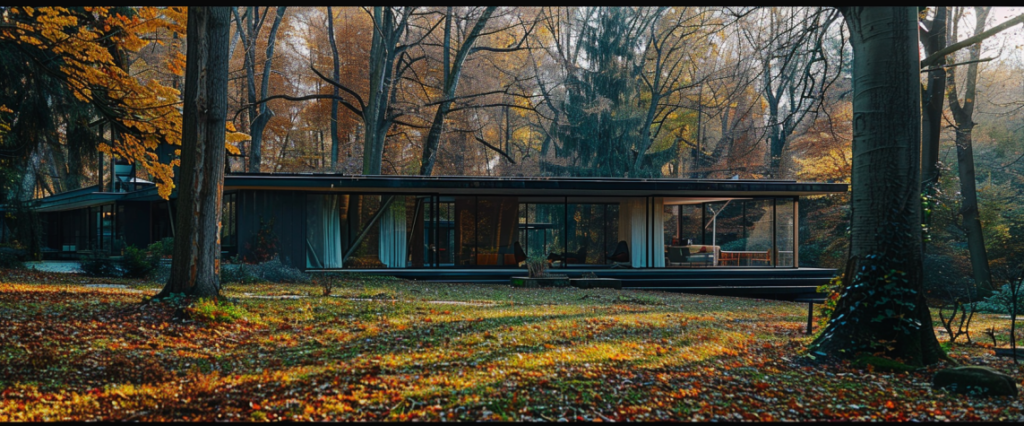
a view of a Mies van Rohe house in a calm forest, with natues. warn color palette --ar 7:3 --style rawAdvanced Design Tools and Capabilities
Midjourney V6 comes equipped with a suite of advanced design tools that cater to both artistic and practical needs. Some of the standout tools include:
- Parametric Design Module: This feature allows architects to manipulate building parameters dynamically, making it easier to explore multiple design iterations quickly.
- Material Simulation Engine: This engine provides an accurate representation of how different materials will look and behave in various environmental conditions, helping architects make more informed decisions.
- Automated Plan Generation: Instead of manually drafting floor plans, architects can now rely on Midjourney V6 to automate this process, ensuring consistency and adherence to design standards.
AI-Powered Innovation
What truly sets Midjourney V6 apart is its AI-powered innovation. The platform continuously learns from vast datasets of architectural designs and trends, providing architects with predictive insights and suggestions that enhance creativity while maintaining functional integrity. The machine learning capabilities enable the system to propose design improvements, optimize space utilization, and even predict potential design flaws before they manifest.
Collaboration and Real-Time Feedback
Midjourney V6 fosters a collaborative environment by enabling real-time feedback and collaboration among team members. Architects, clients, and stakeholders can view and comment on designs in real-time, streamlining the decision-making process and ensuring that everyone is on the same page. This collaborative feature is particularly beneficial in large projects where multiple perspectives need to be considered and integrated harmoniously.
Sustainable Design Practices
In today’s world, sustainability is a crucial consideration in architectural design. Midjourney V6 incorporates tools that help architects create eco-friendly designs. From optimizing natural light usage to integrating renewable energy sources, the AI can guide architects in making sustainable choices that are not only cost-effective but also environmentally responsible.
Midjourney V6 marks a significant leap forward in the field of architectural design. By combining cutting-edge AI technology with practical design tools, it empowers architects to push the boundaries of what is possible. The result is a more efficient, innovative, and collaborative design process that is poised to shape the future of architecture.
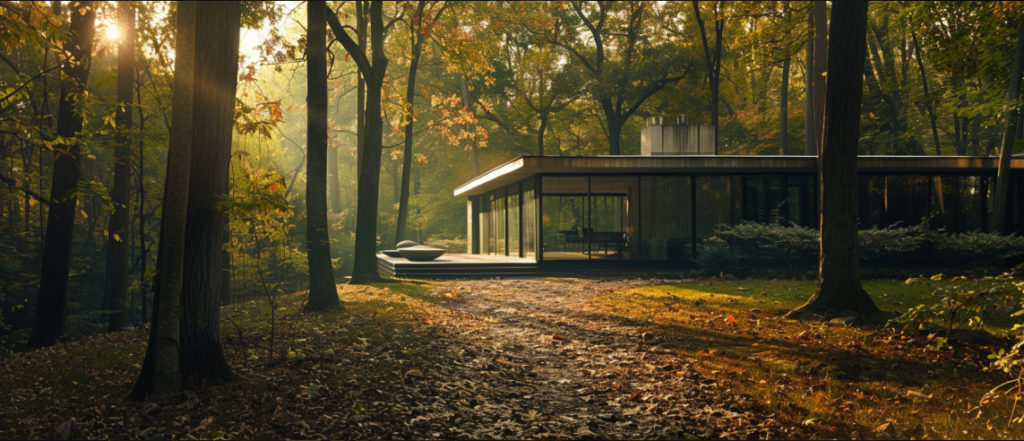
Practical Applications of AI in Architecture
The advancements in artificial intelligence (AI) have transformed many industry landscapes, and architecture is no exception. From initial design concepts to construction and maintenance, AI’s integration into architectural practices has unlocked unprecedented levels of creativity, efficiency, and precision. In this section, we will delve into real-world examples of AI applications in architecture, showcasing successful projects, AI-driven design processes, and how Midjourney V6 has contributed to their success.
AI-Powered Design Processes
One of the most significant contributions of AI in architecture is its ability to streamline and enhance the design process. AI tools can analyze vast amounts of data to inform design decisions, predict structural performance, and visualize project outcomes. For instance, AI can synthesize climate data, zoning laws, and historical building preferences to generate optimized design alternatives tailored to specific locations. This data-driven approach not only accelerates the ideation phase but also ensures that the designs are sustainable and compliant with regulations.
Midjourney V6 stands out in this regard with its sophisticated algorithms that support iterative design processes. Architects can input initial parameters, and the AI model can generate multiple design variations. These models can then be fine-tuned based on client feedback, cost constraints, and material considerations, providing a highly collaborative and adaptive design experience. The rapid prototyping and visualization capabilities of Midjourney V6 have proven to be invaluable for firms aiming to innovate without compromising on quality or efficiency.
Successful Projects Integrating AI
Several groundbreaking projects have showcased the power of AI in architecture, many of which owe part of their success to the advanced features of Midjourney V6. For example, in urban redevelopment projects, AI has been used to simulate and predict the impact of new infrastructure on existing neighborhoods. This entails evaluating traffic patterns, pedestrian flow, and environmental effects, ensuring that new developments are harmonious with their surroundings.
One notable project involved the redesign of a commercial district in a major city. By leveraging Midjourney V6, the architectural firm could create an intricate model that factored in not only the aesthetic and functional aspects of the buildings but also their energy consumption patterns, natural lighting, and community dynamics. The result was a vibrant, sustainable district that won multiple design awards for its innovative use of AI technology.
AI in Construction and Maintenance
Beyond design, AI’s utility extends to the realms of construction and maintenance. AI-driven robotics and machinery can execute complex construction tasks with precision, reducing human error and increasing safety on job sites. Predictive maintenance algorithms can forecast when building systems are likely to fail, allowing for timely interventions that extend the lifecycle of the infrastructure.
Midjourney V6 also plays a role in the ongoing operational efficiency of buildings. By integrating AI with Internet of Things (IoT) devices, architects and engineers can monitor real-time data on building performance. This data can inform adjustments to HVAC systems, lighting, and other utilities, optimizing energy consumption and reducing operational costs.
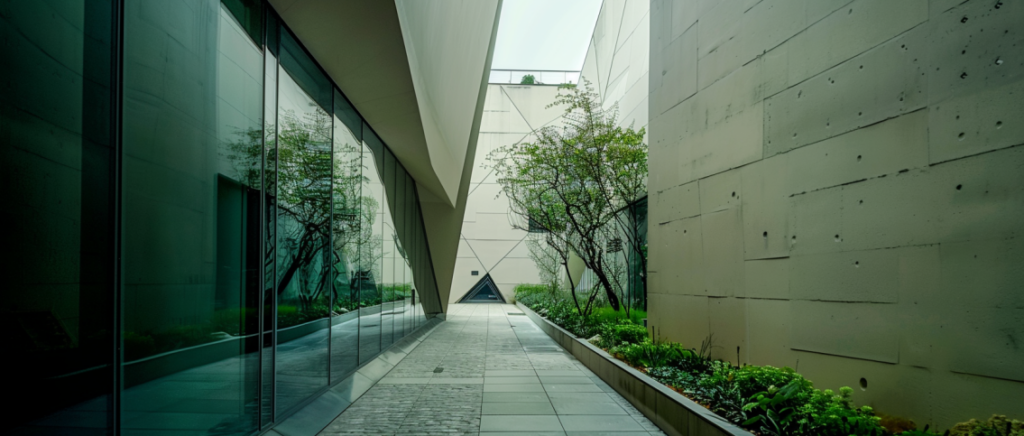
a view of a modern daniel libeskind museum building in an urban courtyard, moody, fragremnted architecture, light color palette. --ar 7:3 --style rawEnhancing Creativity and Efficiency
The advent of AI tools like Midjourney V6 has transformed the architectural landscape, bridging the gap between creativity and efficiency. By leveraging the power of artificial intelligence, architects can now explore innovative design solutions, streamline project workflows, and collaborate more effectively. This section delves into the myriad ways Midjourney V6 augments human creativity and enhances productivity in architectural projects.
1. Collaboration Enhancements
Midjourney V6 facilitates seamless collaboration among architectural teams, clients, and stakeholders. The platform provides a shared virtual space where ideas can be visualized in real-time, enabling immediate feedback and iterative improvements. This dynamic interaction fosters a more inclusive design process, where diverse perspectives converge, ultimately leading to more refined and innovative outcomes. AI-driven tools also translate complex data into intuitive visual models, making it easier for non-experts to engage in the design discussion, thereby enhancing collaborative efforts.
2. Rapid Prototyping
One of the standout features of Midjourney V6 is its ability to generate rapid prototypes. By utilizing advanced algorithms, the platform can transform conceptual sketches into detailed 3D models within minutes. This capability allows architects to quickly experiment with different design iterations, assess their feasibility, and make informed decisions early in the project lifecycle. The speed and precision of rapid prototyping not only save valuable time but also empower architects to embrace a more exploratory and innovative approach to design.
3. Automated Planning
Efficiency in architectural planning is significantly boosted by Midjourney V6’s automation capabilities. The AI can analyze and process large datasets, taking into account variables such as environmental factors, regulatory requirements, and material constraints. Based on this analysis, it can generate optimized design solutions and construction schedules. Automated planning reduces the likelihood of human error, ensures compliance with standards, and highlights potential issues before they become problematic. This strategic foresight leads to more efficient project execution and cost savings.
Blending Creativity with Technical Precision
Midjourney V6 does not replace the architect’s vision but rather amplifies it. By handling routine tasks and complex computations, the AI allows architects to focus more on the creative aspects of their projects. It acts as a catalyst for innovation, offering new perspectives and possibilities that may have remained unexplored in a purely manual process. Moreover, the integration of AI in architecture translates into a more sustainable and responsive design approach, as it enables the testing and refinement of eco-friendly solutions quickly and effectively.
Data Management and Integration
Architects today face numerous challenges when incorporating AI technologies into their workflows. These challenges range from data integration issues and steep learning curves to concerns over creative control and ethical considerations. Midjourney V6, a cutting-edge AI tool, addresses these challenges with tailored solutions that streamline processes, enhance creative freedom, and ensure ethical AI usage. The following table summarizes these key challenges and the corresponding solutions offered by Midjourney V6.
| Key Challenges | Potential Solutions |
|---|---|
| Data Integration Architects often grapple with vast and varied datasets, making it difficult to integrate AI smoothly. Data from different sources may come in a variety of formats and qualities, complicating the seamless incorporation into existing workflows. | Midjourney V6 offers advanced data normalization and compatibility features, ensuring that disparate data formats are unified and compatible. Leveraging automated data preprocessing tools within Midjourney V6 can significantly streamline integration, reducing the manual effort required in data cleansing and conversion. |
| Learning Curve and Technical Proficiency The adoption of AI technologies demands a certain level of technical proficiency that many architects might not possess. This learning curve can hinder the optimal use of AI tools like Midjourney V6. | Midjourney V6 is designed with user-friendly interfaces and comprehensive tutorials to bridge the knowledge gap. Regular training sessions and workshops can facilitate a smoother transition. Additionally, involving collaborative teams, where data scientists and architects work together, can help mitigate this issue and foster a conducive learning environment. |
| Creative Control and Flexibility A common concern among architects is the fear that AI might constrain their creative freedom. Rigid algorithms could potentially limit innovative design solutions. | Midjourney V6 incorporates flexible AI models that are adaptable to an architect’s style and vision. The platform allows for manual adjustments and overrides, ensuring that the architect retains creative control. By using customizable AI settings, architects can tailor the AI’s influence to fit their unique design philosophies. |
| Cost and Resource Allocation Implementing AI solutions can be resource-intensive, requiring significant financial investment in both software and hardware. Smaller firms might find the upfront costs daunting. | Midjourney V6 provides scalable solutions, enabling firms of varying sizes to leverage AI at a manageable cost. Subscription-based models and tiered service levels allow firms to start small and scale up as needed. Additionally, the cloud-based infrastructure of Midjourney V6 reduces the need for extensive on-premises hardware investments. |
| Integration with Existing Software and Processes Many architectural firms rely on a suite of different software tools for varied aspects of their projects. Integrating a new AI tool with these existing systems can be complex and disruptive. | Midjourney V6 boasts robust integration capabilities with popular architectural tools and platforms. APIs and plug-ins are available to facilitate smooth interoperability, ensuring that AI seamlessly fits into existing workflows rather than disrupting them. Customizable workflows can also be designed to accommodate specific project needs. |
| Ethical and Bias Concerns There is growing concern over AI ethics, particularly relating to bias in data and algorithms, which could lead to flawed or biased architectural solutions. | Midjourney V6 embeds ethical guidelines and bias detection mechanisms within its AI models. Continuous monitoring and updating of the AI systems help ensure fairness and accuracy. Architects are encouraged to use diverse and representative data sets to train AI models, minimizing the risk of bias. |
By addressing these challenges with targeted solutions using Midjourney V6, architects can harness the full potential of AI-driven tools to enhance their workflows. This not only paves the way for more innovative and efficient design processes but also ensures that AI integration is smooth, cost-effective, and ethically sound. The advanced features of Midjourney V6 support architects in overcoming barriers to AI adoption, allowing for a seamless and creative design experience.
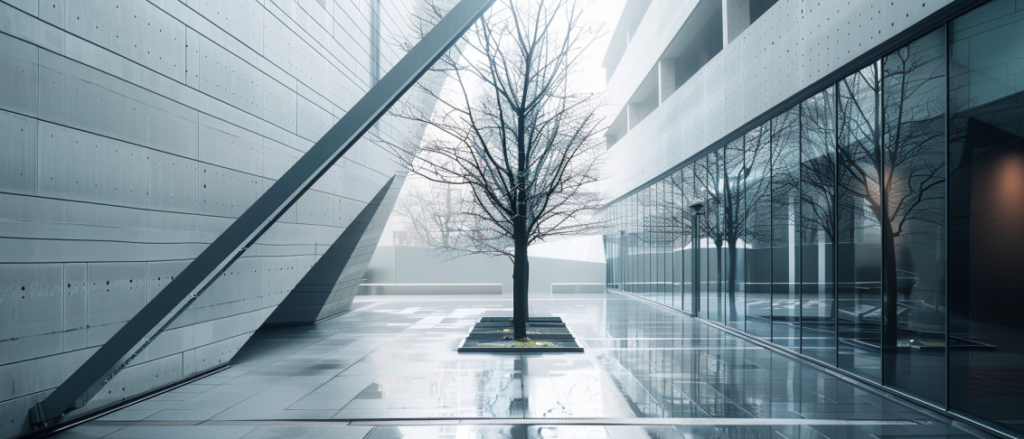
Future Trends and Predictions in AI Architecture
As we gaze into the future of AI architecture, the landscape promises to be a fascinating realm of innovation and transformation. The integration of AI into architectural design through advanced tools like Midjourney V6 is just the beginning. This section aims to provide informed predictions about the possible trajectories AI might take in shaping the architecture of tomorrow.
Enhanced Design Efficiency
One of the foremost trends in AI architecture is the continued enhancement of design efficiency. With tools like Midjourney V6 already pushing the boundaries of what’s possible, future iterations are likely to further streamline the design process. Architects will have at their disposal increasingly intelligent systems capable of understanding and implementing complex design requirements with minimal human input. This improved efficiency will not only reduce the time required to create architectural models but also elevate the quality and precision of those designs.
Integration of Multidisciplinary AI
The future will likely see a more pronounced integration of AI systems across various disciplines within architecture. Beyond just design, AI will infiltrate construction management, material science, and even HVAC systems to optimize building performance. Tools like Midjourney V6 will evolve to incorporate insights from structural engineers, environmental scientists, and urban planners, creating a more holistic approach to building design and sustainability.
Data-Driven Design Innovations
As data becomes increasingly integral to all aspects of life, AI-driven architecture will harness vast datasets to inform and innovate design processes. Predictive analytics will be used to anticipate and counteract structural challenges, while real-time data from smart cities will guide adaptive and responsive architectural solutions. Midjourney V6 and similar tools will become even more adept at analyzing and incorporating this data, generating designs that are not only aesthetically pleasing but also highly functional and sustainable.
Customization and Personalization
The next wave of AI architecture will see an upsurge in customization and personalization capabilities. AI will enable architects to create bespoke designs tailored precisely to individual clients’ needs and preferences. Midjourney V6 will offer increasingly sophisticated options for personalizing spaces, from adjusting spatial layouts to selecting materials that reflect individual tastes and lifestyles. This trend will make architecture more personal and human-centric, ensuring that spaces not only serve their purpose but also resonate deeply with their inhabitants.
AI and Sustainable Design
Sustainability will remain at the forefront of architectural priorities, and AI will play a pivotal role in this endeavor. Future advancements in AI will facilitate the design of buildings that are not only energy-efficient but also environmentally regenerative. Midjourney V6 and its successors will integrate green technologies and intelligent systems that optimize energy consumption, reduce waste, and enhance overall ecological balance. This focus on sustainability will drive the development of buildings that contribute positively to their surroundings and serve as benchmarks for responsible design.
The Rise of Virtual and Augmented Reality
The fusion of AI with virtual and augmented reality (VR/AR) will revolutionize architectural design and presentation. Architects will be able to create immersive, interactive experiences for clients, allowing them to virtually walk through and experience designs before they are built. Midjourney V6 will likely incorporate VR/AR capabilities to provide a fully immersive design process, enhancing client engagement and satisfaction. This technological convergence will lead to more informed decision-making and greater alignment between clients’ visions and the final product.
Collaborative AI Ecosystems
Lastly, the future will see the emergence of collaborative AI ecosystems. These ecosystems will involve interconnected AI platforms that work seamlessly together to deliver comprehensive architectural solutions. Platforms like Midjourney V6 will not operate in isolation but as part of a larger network of AI tools, each contributing unique capabilities to the design process. This collaborative approach will advance the field of architecture, fostering innovation through shared intelligence and collective problem-solving.
In conclusion, the future of AI in architecture, exemplified by advancements in tools like Midjourney V6, is poised to be a thrilling journey of innovation and transformation. As efficiency improves, sustainability becomes paramount, and customization reaches new heights, the architecture of tomorrow will be smarter, greener, and more attuned to human needs. These trends and predictions offer a glimpse into a future where AI not only augments human capabilities but also redefines the very essence of architectural design.
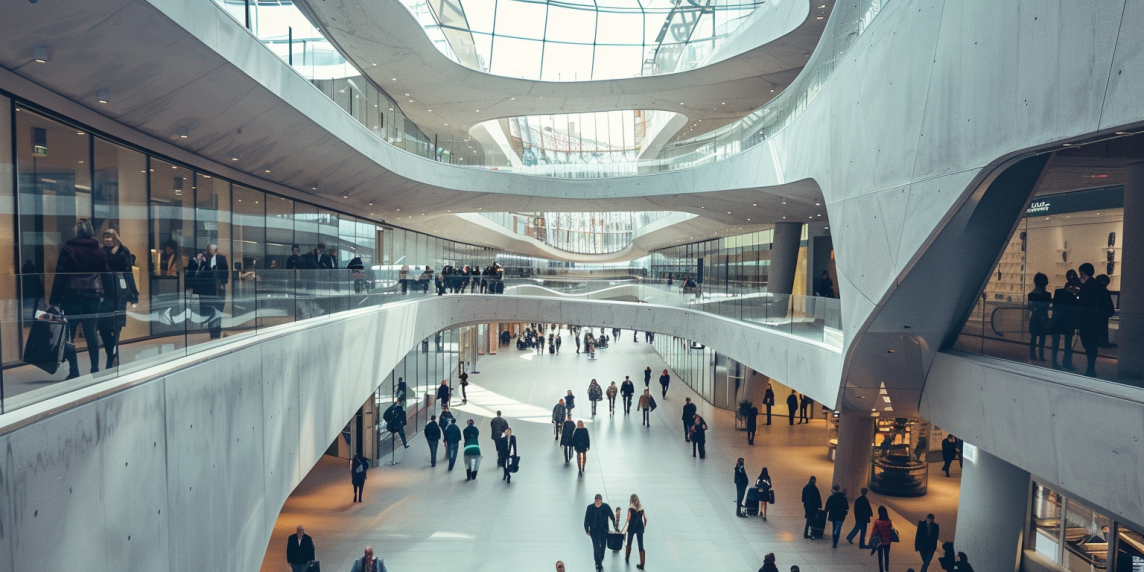
Leave a Reply